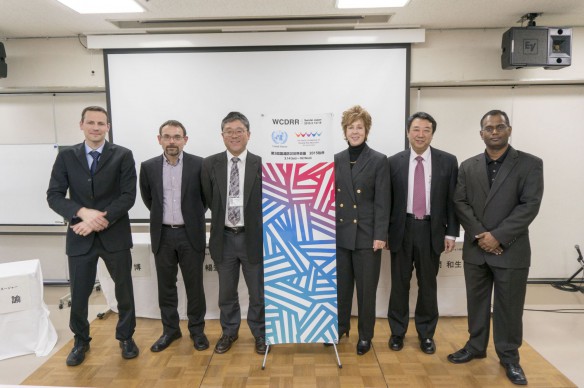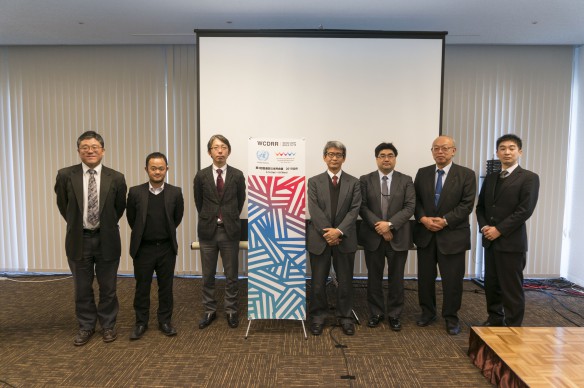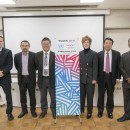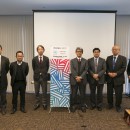ID:189 Social Implementation of Disaster Robots and Systems - Current State, Gap and Action Plans for the Future
- Date
- 2015-03-14(Sat)
- Time
- 13:30-16:00(Door Open 13:00)
- Venue
- Tokyo Electron Hall Miyagi 601
Report has released
- Language
- Japanese,English
- Translation
- Simultaneous interpretation
Contact/Entry
E-mail:tadokoro*rm.is.tohoku.ac.jp (Please replace * to @)
International Research Institute of Disaster Science, Tohoku University
Organization
Tohoku University International Research Institute of Disaster Science (IRIDeS)
Co-organization
IEEE
International Rescue System Institute
COCN Disaster Robot Project and ImPACT Tough Robotics Challenge
Tags
Report
| Number of participants | ID189 : 120 / ID94 : 90 |
|---|
ID189 Social Implementation of Disaster Robots and Systems: Current State, Gap and Action Plans for the Future
* MAIN OUTCOME
World top-runners introduced the current state and gap to social implementation of disaster robotics, and discussed actions to be taken for the disaster risk reduction. A voluntary commitment of establishing an international committee of all relevant stakeholders to accelerate implementation of robotics in national disaster management plans was announced.
* GOVERNMENT ANNOUNCEMENTS AND VOLUNTARY COMMITMENTS MADE AT THE EVENT
The establishment of an international committee of all relevant stakeholders as a way to accelerate the implementation of Robotics and ICT for national disaster management plans and national regulations synchronizing with rapid technology revolution.
* QUOTAS FROM PARTICIPANTS
Strong support to robotics and its potential contribution to disaster risk reduction
* ANY OTHER INFORMATION TO BE HIGHLIGHTED
Surprise of audience about application of robots so far
ID94 Social Implementation of Disaster Robots and Systems: Application Record and Challenge for the Future
* MAIN OUTCOME
Application of robotic systems to Fukushima-daiichi emergency response, decommissioning of plants, unmanned construction system, and landslide was introduced by Japanese companies and universities. A voluntary commitment of establishing an international committee of all relevant stakeholders to accelerate implementation of robotics in national disaster management plans was announced.
* GOVERNMENT ANNOUNCEMENTS AND VOLUNTARY COMMITMENTS MADE AT THE EVENT
The establishment of an international committee of all relevant stakeholders as a way to accelerate the implementation of Robotics and ICT for national disaster management plans and national regulations synchronizing with rapid technology revolution.
* QUOTAS FROM PARTICIPANTS
Technical issues of robots and their application
* ANY OTHER INFORMATION TO BE HIGHLIGHTED
Surprise of audience about application of robots so far
Outline
This symposium introduces the current state of disaster robots and the gap to their social implementation by the world top-runners, and discusses the action plans to be taken for the future disaster mitigation.Robotics is becoming a powerful tool for disaster mitigation, response and recovery after its history of 50 years. For example, unmanned aerial vehicles quickly surveyed wide disaster areas, remotely-operated underwater vehicles repaired leakage of subsea oil plants, and unmanned ground vehicles worked in contaminated areas of damaged nuclear power plants.
The contribution of robotics is mainly 1) for performing tasks that human and conventional tools cannot (e.g. those at inaccessible places and in contaminated areas), 2) for reducing risks (e.g. those of potential explosion, toxic agents and radiation), and/or 3) for reducing time and cost (e.g. quick surveillance of potentially damaged facilities at high places without scaffolds).
The recent evolution of robotics and component technologies is rapidly enhancing their applicable areas and tasks. Remote robotic systems, for example, could gather information from sky 20 years ago. At present, they can approach to structures of interest in the neighborhood for detailed visual inspection from sky, and can enter damaged buildings through narrow entrance for searching victims. Autonomy and robot intelligence reduce responders' load, and integrate gathered information with measured 3D maps. For this reason, specialists predict that robotics would become an essential tool of disaster mitigation, response and recovery in ten years.
Detail
Session 0: Robot Demonstration
15:00-18:00pm, Thursday, March 12, 2015
Tohoku University, Research Center for Rare Metal and Green Innovation, Aobayama East Campus
Bldg. J02 in http://www.eng.tohoku.ac.jp/english/map/?menu=campus&area=j
Directions: http://www.eng.tohoku.ac.jp/english/map/directions.html
Session Abstract:
This demonstration shows the most recent R&D and application of disaster robotics in Tohoku University.
Program:
TBD
Session 1: Current State, Gap and Action Plans for the Future
13:30-16:00, Saturday, March 14, 2015
Tokyo Electron Hall Miyagi, Room 601
Venue D in http://www.bosai-sendai.jp/public_map.html
Directions: 5 min. walk from Sendai Subway Kotodai Station.
Session Abstract:
This symposium introduces the current state of disaster robots and the gap to their social implementation by the world top-runners, and discusses the action plans to be taken for the future disaster mitigation.
Program:
13:30-14:00
Japan’s disaster robotics (tentative)
Speaker:Hajime Asama, University of Tokyo, Japan
14:00-14:30
Current state and achievement of disaster robotics (tentative)
Speaker: Robin Murphy, Texas A&M University, USA
14:30-15:00
Research and application of disaster robotics in EU (tentative)
Speaker:Gerald Steinbauer, Technical University of Graz, Austria
15:00-15:30
EU ICARUS Project (tentative)
Speaker:Geert De Cubber, Royal Military Academy, Belgium
15:30-16:00
Activities of IEEE Special Interest Group of Humanitarian Technology (tentative)
Speaker:Raj Madhavan, University of Maryland, USA
Related Session Organized by Japan Cabinet Office
16:00-19:00, Saturday, March 14, 2015
Tokyo Electron Hall Miyagi, Room 601
Venue D in http://www.bosai-sendai.jp/public_map.html
Directions: 5 min. walk from Sendai Subway Kotodai Station.
Program (TBD):
16:00-16:30 R&D programs organized by Japan Cabinet Office
16:30-17:00 Impact R&D program
17:00-17:30 SIP R&D programs
…..
Session 2: Application Record and Challenge for the Future
Monday, March 16, 2015 9:50-11:50am
TKP Garden City Sendai Kotodai Hall 1 (Sendai Park Bldg.)
Venue E in http://www.bosai-sendai.jp/public_map.html
Directions: Adjacent to Sendai Subway Kotodai Station.
Session Abstract:
This symposium introduces the record of application of robots and robotic systems to the world disasters, and discusses their challenges for the future disaster mitigation.
Program:
09:50-10:10
Unmanned ground vehicles Quince and Sakura for Fukushima-Daiichi response (tentative)
Speaker:Tomoaki Yoshida, Chiba Institute of Technology
10:10-10:30
Robots for Fukushima-Daiichi decommissioning (tentative)
Speaker:Satoshi Okada, Hitachi Ltd.
10:30-10:50
Efforts using robot technologies for decommission at Fukushima Daiichi nuclear power plant
Speaker:Takuya Uehara, Toshiba Corp.
10:50-11:10
Activities of J-NEASE by electric power companies in Japan
Speaker:Sunao Tomimori, Nuclear Emergency Assistance Center (J-NEACE), The Japan Atomic Power Co.
11:10-11:30
Unmanned construction system – the history and future (tentative)
Speaker:Shigeo Kitahara, Kumagai Gumi Co. Ltd.
11:30-11:50
Application of UAVs for Hiroshima landslide disaster in 2014 (tentative)
Speaker: Yutaka Watanabe, Luce Search Co. Ltd.








